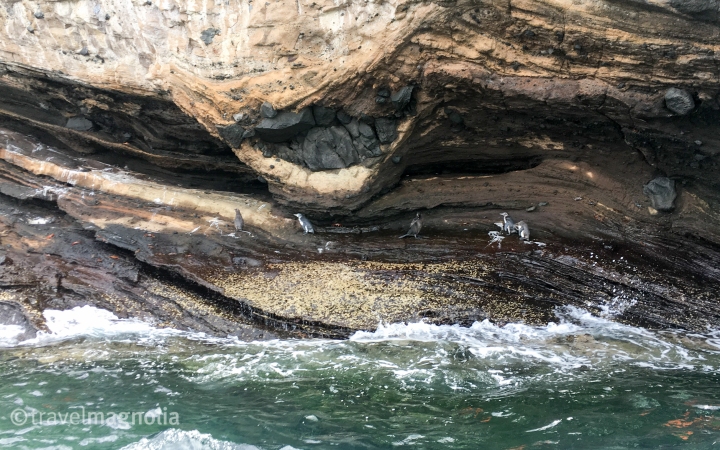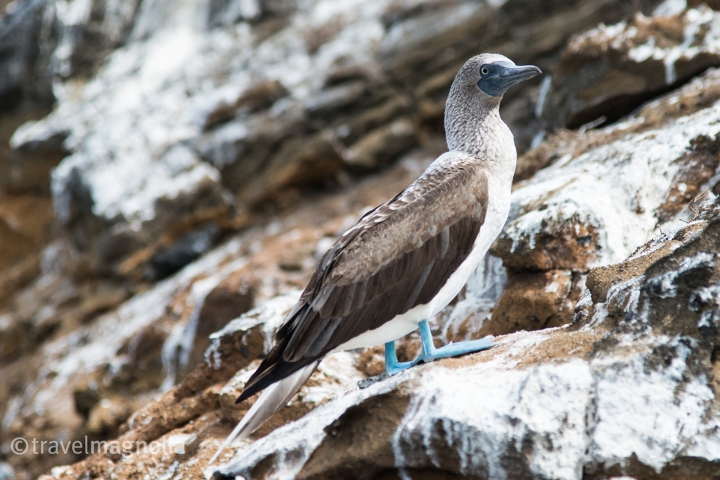While many people associate the Galápagos with Charles Darwin and his theories of evolution, what they may not realize is that the islands themselves evolve over time as well. The tectonic plates that caused the volcanic eruptions that became islands continue to move eastward at the rate of a few inches a year.

One of the westernmost islands, Isabela is the largest of the archipelago (approximately 1800 square miles). The island’s shape resembles a large seahorse with Fernandina tucked in between its snout and tail (check it out on this map).
 The geology shows the changes wrought by erosion and explosion over the millennia.
The geology shows the changes wrought by erosion and explosion over the millennia.  More incredible geology as well as a first glimpse of the Galápagos Penguins that gives an idea of their diminutive stature: 19″ and under five pounds! Many more photos and info on them in a future post.
More incredible geology as well as a first glimpse of the Galápagos Penguins that gives an idea of their diminutive stature: 19″ and under five pounds! Many more photos and info on them in a future post. The gregarious brown pelicans greeted us almost everywhere we went and their antics provided a lot of amusement.
The gregarious brown pelicans greeted us almost everywhere we went and their antics provided a lot of amusement.


One of the more unusual fauna in the Galápagos, the flightless cormorant is endemic to the Galápagos and found only on Isabela and Fernandina islands. It is the largest cormorant but also the only one that has lost its ability to fly.
The Brown Noddy, a member of the tern family, blended in so well that it was only in reviewing pictures that we realized just how many there were.


The Blue Footed Booby has an almost regal look in contrast with its hysterical name. The bluer the feet, the more attractive the male as a prospective mate.

We saw hundreds of these birds, and acres of their guano, too!

Isabela is also home to the Galápagos Land Iguana which can grow up to five feet long and 25 pounds. As with so many other endemic species, its camouflage makes it difficult to spot (unless it is crossing the path as above).

Darwin Lake lies in a volcanic crater a few hundred feet above Tagus Cove. It is an easy two-kilometer walk and provides wonderful vistas across Isabela. The trees in the foreground are Palo Verde, one of the few species to grow on the Galápagos. Within a few weeks of this shot, the first rains came and the branches erupted in green.
Next up: Fernandina, the newest island and Isabela’s closest neighbor.
If you missed the overview of this amazing trip, check out: Seven Wonders of The Galápagos!


Love this post!
LikeLiked by 1 person
Thank you so much! It was a magical place.
LikeLike
Incredible pics (as usual)!! I like the Sally Lightfoots in particular.
LikeLiked by 1 person
Thanks for stopping by. The Sally Lightfoots are great and I promise many many more…!
LikeLike
Great photos!
LikeLiked by 1 person
This is amazing! I’ve never seen a bird with blue feet before. How did you visit the islands?
LikeLiked by 1 person
The Galápagos are totally amazing! Glad you stopped by and there are more incredible birds and animals to come. We were on a cruise which is fundamentally the only way to visit.
LikeLiked by 1 person
What an amazing place with astounding creatures. I am fascinated by the vivid colorings so many of them have.
LikeLiked by 1 person
Thanks for stopping by! The incredible thing is how even these very colorful creatures have camouflage that works so well!
LikeLiked by 1 person
I’m so glad I’m getting a chance to catch up with your posts at last! Isabela looks incredible – and I’ve never seen one of those land iguanas before! What an amazing colour!
LikeLiked by 1 person
Thanks Helen! I think the Beasties would feel right at home in the Galápagos!
LikeLiked by 1 person